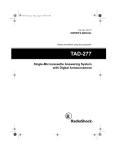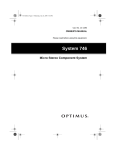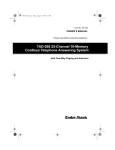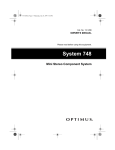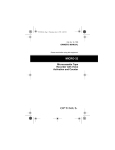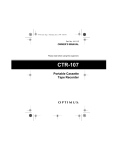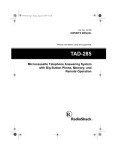Download Radio Shack TAD-1018 Owner`s manual
Transcript
Cat. No. 43-778 OWNER’S MANUAL Please read before using this equipment. TAD-1018 Single Microcassette Answering System with Trim-Style Phone FEATURES Your RadioShack TAD-1018 Single Microcassette Answering System with Trim-Style Phone is ideal for your home or office. This combination telephone and answering system is easy to use and has many special features. ANSWERING SYSTEM VOX (Voice-Activated Recording) — stops recording after 7 seconds of silence to conserve tape space for other messages. Supplied Incoming Message Tape — lets you record up to about 29 minutes of incoming messages on each side of the tape. Digital Outgoing Message — ensures the clearest possible recording of the message you leave for callers. Volume Control — lets you set the volume of the system’s speaker. Call Screening — lets you listen while a caller leaves a message so you can decide if you want to answer the call. TELEPHONE Adjustable Ringer — lets you turn the ringer on or off. Auto-Reset — stops recording when you pick up any phone on the same line. Redial — dials the last number dialed, with the press of a button. Useful when trying to reach a busy number. Remote Operation — lets you use a touch-tone phone (or rotary phone and pocket tone dialer) to operate the answering system while you are away from your home or office. Flash — generates a timed switchhook signal for use with special services, such as Call Waiting. Remote Answer-On — lets you call from a remote location to set the answering system to answer calls. Selectable Toll Saver — lets you avoid unnecessary toll charges when you call by long-distance to check your messages. Volume Control — lets you set the volume of the sound you hear through the handset. Touch-Tone or Pulse (Rotary) Dialing — you can use this telephone with either type of service. © 1997 Tandy Corporation. All Rights Reserved. RadioShack is a registered trademark used by Tandy Corporation. 2 We recommend you record your system’s serial number here. The number is on the bottom of the answering system. Serial Number: This system has been tested and found to comply with all applicable UL and FCC standards. WARNING: To reduce the risk of fire or shock hazard, do not expose this product to rain or moisture. CAUTION RISK OF ELECTRIC SHOCK. DO NOT OPEN. ! CAUTION: TO REDUCE THE RISK OF ELECTRIC SHOCK, DO NOT REMOVE COVER OR BACK. NO USER-SERVICEABLE PARTS INSIDE. REFER SERVICING TO QUALIFIED PERSONNEL. ! READ THIS FIRST We have designed your system to conform to federal regulations, and you can connect it to most telephone lines. However, each device you connect to the phone line draws power from the phone line. We refer to this power draw as the device’s ringer equivalence number, or REN. The REN is on the bottom of your answering system. If you are using more than one device on the line, add up all the RENs. If the total is more than five, your phones might not ring and your answering system might not answer. In rural areas, a total REN of three might impair ringer operation. If ringer operation is impaired, remove a device from the telephone line. FCC STATEMENT This symbol is intended to alert you to the presence of uninsulated dangerous voltage within the product’s enclosure that might be of sufficient magnitude to constitute a risk of electric shock. Do not open the product’s case. Your answering system complies with Part 68 of FCC Rules. You must, upon request, provide the FCC registration number and the REN to your phone company. Both numbers are on the bottom of your answering system. This symbol is intended to inform you that important operating and maintenance instructions are included in the literature accompanying this product. Note: You must not connect your answering system to: • Coin-operated systems • Party-line systems • Most electronic key phone systems 3 CONTENTS Installation ............................................................................................................ 5 Selecting a Location ........................................................................................ 5 Loading the Cassette ....................................................................................... 5 Connecting Power ........................................................................................... 6 Recording the Outgoing Message ................................................................... 6 Checking the Outgoing Message .............................................................. 7 Placing the Phone on a Desk Top ................................................................... 8 Mounting the Phone on the Wall ..................................................................... 8 Turning Off/On the Ringer ............................................................................. 10 Setting the Number of Rings ......................................................................... 10 Setting the Dialing Mode ............................................................................... 10 Telephone Operation ......................................................................................... Using Pause .................................................................................................. Using REDIAL ............................................................................................... Using FLASH ................................................................................................. Setting the Phone’s Volume .......................................................................... Using Tone Services with a Pulse Line .......................................................... 12 12 12 12 13 13 Answering System Operation ........................................................................... Setting the Answering System to Answer Calls ............................................. Setting the Recording Time ........................................................................... Setting the Answering System’s Volume ....................................................... Screening Calls ............................................................................................. Playing Messages ......................................................................................... 14 14 14 14 15 15 Remote Control Operation ................................................................................ Remote Playback .......................................................................................... Erasing the Messages ................................................................................... Remote Answer-On ....................................................................................... 17 17 17 18 Troubleshooting ................................................................................................. 19 Care and Maintenance ....................................................................................... Cleaning the Tape-Handling Parts ................................................................. The FCC Wants You to Know ........................................................................ Lightning ........................................................................................................ 4 21 22 22 22 INSTALLATION SELECTING A LOCATION 1. Turn the supplied cassette’s hub with the tip of a pencil to take up any tape slack. You can set the TAD-1018 on a flat surface (such as a desk top or counter top), or mount it on a wall plate or directly on the wall. Select a location that is: • Near an AC outlet 2. Lift open the cassette compartment door. • Near a modular phone line jack If the phone line jack is not a modular jack, you must update the wiring. You can convert the wiring yourself, using jacks and adapters available at your local RadioShack store. Or, you can let the phone company update the wiring for you. Note: The USOC number of the jack to be installed is RJ11C. LOADING THE CASSETTE 3. Put the cassette in the compartment with its full reel toward the back of the answering system and its open edge to the right. Your answering system comes with an MC-60 cassette tape (30 minutes of recording time per side). You can buy additional and different length cassettes at your local RadioShack store. 4. Close the compartment door. 5 Notes: • You can turn the tape over and record on the other side. This lets you save any messages recorded on the first side while using the tape to record more messages. • Replace the tape at least once a year, or more often if it is used frequently. CONNECTING POWER Use the supplied AC adapter to power your answering system. Cautions: • Use only the supplied adapter. • Always plug the adapter into the answering system before you plug it into an AC outlet. Always unplug the adapter from the AC outlet before you unplug it from the answering system. Follow these steps to connect the TAD-1018 to power. 1. Plug the AC adapter’s barrel plug into the answering system’s POWER SOURCE jack. 2. Plug the other end of the adapter into a standard AC outlet. 6 The MESSAGE indicator lights while the answering system checks for an outgoing message. If an outgoing message is already recorded, the answering system automatically plays it back. If there is no outgoing message, the answering system sounds a continuous tone until you record a message (see “Recording the Outgoing Message”). Note: If the cassette tape is broken or is not inserted properly and the answering system has power, the system sounds a continuous tone. To stop the tone, unplug the adapter from the AC outlet. Reinsert or replace the cassette tape, then plug the adapter back into the AC outlet. RECORDING THE OUTGOING MESSAGE Before you can set the answering system to answer calls and record messages, you must record the message the caller hears when the answering system answers a call. In the message, ask for the caller’s name, phone number, and message. The maximum length for your outgoing message is 30 seconds. Important Hint: Do not tell callers that you are not home. Instead, say that you cannot come to the phone right now. Follow these steps to record your outgoing message. 1. Rotate VOLUME on the base to the right until it clicks. The MESSAGE indicator lights. 2. Lift open the cassette compartment door. 3. Hold down OGM REC/PLAY until the MESSAGE indicator turns off, then release the button. The answering system beeps once. 5. When you finish recording your message, press OGM REC/PLAY again. The MESSAGE indicator turns off, then the answering system beeps twice and plays back the message as it is recording from the digital chip to the tape. (The message is backed up on tape so after a power failure it can be automatically restored to the chip.) Wait until the answering system plays back the message before you continue installing your answering system. Checking the Outgoing Message Press OGM REC/PLAY at any time to hear the outgoing message. The answering system beeps once, plays back the message, beeps twice, then resets to answer calls. 4. When the MESSAGE indicator lights again, speak clearly in a normal voice about 12 inches away from the microphone. To adjust the volume, rotate VOLUME. Microphone 7 PLACING THE PHONE ON A DESK TOP To use your answering system on a desk, table, or shelf, plug the telephone cord into a modular phone jack. Plug one end of the coiled handset cord into the handset jack on the answering system and the other end into the jack on the handset. Place the handset on the cradle. MOUNTING THE PHONE ON THE WALL Using the supplied mounting bracket, you can mount the TAD-1018 on a phone jack wall plate or directly on the wall. If you are mounting the phone directly on the wall, you need two screws with heads that fit into the bracket’s keyhole slots. 8 1. Pull the handset holder toward you as far as it will go. Hold it out as you rotate the holder 180°, then let it snap back in place. The holder’s tab holds the handset in the cradle while the answering system is mounted on the wall. 2. To mount the TAD-1018 directly onto the wall, drill two holes 31/4 inches apart, one above the other, at the desired location. 3. Thread a screw into each hole until it’s head extends about 1/8 inch from the wall. 1 /8” 4. If you are mounting the system on a wall plate, thread the telephone cord into the left slot on the top of the mounting bracket and pull it through the large hole in the center of the bracket. If you mounting the system directly on the wall, thread the telephone cord into the left slot on the top and bottom of the mounting bracket. Thread the adapter’s power cord into the right slot on the top and bottom of the mounting bracket. 6. When mounting on a wall plate, coil all the excess telephone cord into the mounting bracket’s recess by pushing it back through the large hole. Leave only about 1–2 inches of the cord outside the bracket. 7. Plug the telephone cord into the wall plate or a modular phone jack. 5. Insert the mounting bracket’s tabs into the slots on the bottom of the answering system. Then push the bracket up until it snaps into place. 8. Line up the keyhole slots on the bracket with the studs on the wall plate (or with the screws in the wall), then slide the bracket down until it is secure. 9 9. Plug one end of the coiled handset cord into the handset jack on the answering system and the other end into the jack on the handset. Place the handset in the cradle. TURNING OFF/ON THE RINGER To turn off the telephone’s ringer, set RINGER to OFF. You can still make outgoing calls. If you hear an extension phone ring, you can still answer calls. The system answers calls in 2, 4, or 7 rings, or if you set the switch to TS (Toll Saver — the last position), the answering system answers in 4 rings if no messages are saved or in 2 rings if you have messages. Toll Saver can save you long-distance charges because, if there are no new messages, you can hang up before the answering system answers. SETTING THE DIALING MODE Pick up the handset, then set TONE/ PULSE for the type of service you have. When you want the telephone to ring again, set RINGER to ON. SETTING THE NUMBER OF RINGS You can select the number of rings the answering system waits before it answers calls. Set RING SELECT to the desired position. If you are not sure which type you have, do this test. 1. Pick up the handset and listen for a dial tone. 2. Set TONE/PULSE to TONE. 3. Press any number other than 0. 10 Note: If your phone system requires that you dial an access code (9, for example) before you dial an outside number, do not press the access code either. If the dial tone stops, you have touch-tone service. Leave TONE/ PULSE set to TONE . If the dial tone continues, you have pulse service. Set TONE/ PULSE to PULSE. Notes: • # does not function when TONE/ PULSE is set to PULSE. • If you have pulse service and want to use a special service that requires tone signals (such as bank-by-phone), see “Using Tone Services with a Pulse Line” on Page 13. 11 TELEPHONE OPERATION You can make and answer calls with this telephone as you would with any other phone. Read this section to learn about special features. USING PAUSE USING REDIAL To quickly dial the last number dialed, press REDIAL. The redial memory stores up to 32 digits so you can quickly redial local as well as longdistance numbers. In some telephone systems, you must dial an access code ( 9, for example) and wait for a second dial tone before you can dial an outside number. You can enter a pause after the access code to allow the outside line time to connect. To enter a 4-second pause while dialing a phone number, press PAUSE . For a longer pause, press PAUSE additional times. USING FLASH Many special phone services, such as Call Waiting, require a switchhook signal. Pressing FLASH performs the electronic equivalent of a switchhook operation. For example, if you subscribe to Call Waiting, press FLASH to put your current call on hold and answer an incoming call on the same line. Press FLASH again to alternate between the two calls. 12 Note: If you do not have any special telephone services, pressing FLASH might disconnect your current call. USING TONE SERVICES WITH A PULSE LINE SETTING THE PHONE’S VOLUME Some special services, such as alternate long-distance and bank-byphone, require tone signals. If you have pulse service, you can still use special services by following these steps. Slide VOL (volume) on the handset to set the handset’s volume to the desired level. 1. With TONE/PULSE set to PULSE, call the special service. 2. When the service answers, press TONE. Any additional numbers you dial are sent as tone signals. 3. When you complete the call, hang up the phone. The phone automatically changes back to the pulse mode. 13 ANSWERING SYSTEM OPERATION SETTING THE ANSWERING SYSTEM TO ANSWER CALLS Rotate VOLUME on the base to the right. When the MESSAGE indicator stays on without the answering system sounding a tone, the system is ready to answer calls. The answering system records messages and hangs up and resets to answer the next call when: hangs up. See “Remote Control Operation” on Page 17. To have the answering system not answer calls, rotate VOLUME to OFF. The MESSAGE indicator turns off. SETTING THE RECORDING TIME You can select the length of recording time for incoming messages. Slide REC TIME to 1 MIN to set the TAD to record for up to 1 minute for each message or to 5 MIN for up to 5 minutes. • The caller hangs up. • The maximum message length of about 1 minute or 5 minutes is reached. • There are more than 7 seconds of silence. The answering system can record up to about 29 minutes of incoming messages on the supplied tape. If the tape reaches the end while a caller is leaving a message, the answering system beeps twice and hangs up. If the incoming message tape is full, the answering system answers a call after 10 rings, plays back the outgoing message, then waits 7 seconds for the remote operation security code. If the correct code is not entered, the answering system beeps twice and 14 SETTING THE ANSWERING SYSTEM’S VOLUME Adjusting the answering system’s VOLUME control sets the speaker vol- ume. (This does not affect the volume of the message the caller hears.) SCREENING CALLS To screen calls, let the answering system answer them, then listen to the caller’s message through the answering system’s speaker. If you decide to answer the call, pick up any phone on the same phone line as the answering system (including the system’s phone). The answering system stops recording and resets to answer the next call. Note: If you pick up the phone just as the answering system answers, the answering system might not stop recording the message. If this happens, hang up the phone for a moment then pick it up again. PLAYING MESSAGES When you have messages, the MESSAGE indicator flashes. If you have four messages or less, the light flashes once for each message stored. (For example, if you have two messages, the light flashes twice, pauses, then flashes twice more, and so on.) If you have more than four messages, the light flashes continuously. To play the messages, press PLAY . The answering system beeps, rewinds, then plays the messages. To pause playback for up to 60 seconds, press PLAY . To restart playback, press PLAY again. Notes: • If you do not restart playback within 60 seconds, the tape fastforwards to the end of the last recorded message, as though playback was never started. • If a call comes in while playback is paused, the tape fast-forwards to the end of the last recorded message and then answers the call. • If you turn VOLUME to OFF during playback, the system stops playback, the tape fast-forwards to the end of the last recorded message, and the MESSAGE indicator turns off, as though playback was never started. All messages are saved. After you play back all the messages, the answering system beeps twice and resets to answer calls. New messages will be recorded over the messages you have heard. 15 To save the messages, press SAVE before a new call is recorded. The tape fast-forwards to the end of all the messages and resets to answer calls. To replay the messages, simply press PLAY again. 16 REMOTE CONTROL OPERATION While you are away from your home or office, you can use a touch-tone phone or a pulse phone with a pocket tone dialer to: • Play your messages • Erase your messages • Set the answering system to answer calls Note: If you do not enter the code within 7 seconds, the answering system hangs up. The answering system plays back the incoming messages. At the end of all the messages, the answering system sounds single beeps and tones then four short beeps. REMOTE PLAYBACK Note: The answering system automatically saves your messages after remote playback. You must know your remote operation security code to play back your messages from a remote phone. This code (a 3-digit number) is on the bottom of your answering system. To replay the messages, wait about 8 seconds after the four short beeps. When you hear a single beep, enter the remote operation security code again. To play back your messages from a remote phone, follow these steps. 1. Dial your phone number. If RING SELECT is set to TS , the answering system answers on the second ring if there are messages. If there are no messages, the answering system answers on the fourth ring. 2. After the outgoing message stops and a beep sounds, enter the remote operation security code within 5 seconds. Be sure each button press is at least 1/2 second long. The answering system sounds a tone while the tape rewinds. If no tone sounds, re-enter the code. ERASING THE MESSAGES If you want to erase the messages after playback, enter the remote operation security code within 8 seconds after the four short beeps at the end of all the messages. After the answering system beeps, hang up the phone. Note: After you erase messages by remote, you cannot recover them (even if you press SAVE as soon as you get back to your answering system). 17 REMOTE ANSWER-ON You can use any remote phone to set the answering system to answer calls if: • The answering system has power, • The cassette is loaded, and • The answering system is off. To set the answering system to answer calls, dial your phone number and wait about 60 seconds until the answering system answers. Then hang up the phone. Note: Be sure to turn on the system when you get home, to play back any recorded messages. 18 TROUBLESHOOTING We do not expect you to have any problems with your answering system, but if you do, be sure you installed the tape correctly. If you still have a problem, this chart might help. If it does not, take the answering system to your local RadioShack store for assistance. Problem The answering system does not answer and record callers’ messages. Cause Solution The system is turned off. Turn on the answering system by rotating VOLUME to the right. The outgoing message is not recorded. Record an outgoing message. Bad phone line connection. Check and reconnect the modular phone plugs. Check to see if the phone works properly. Be sure you have electrical power. The answering system records a dial tone, beeping, or the operator’s voice instead of the caller’s message. The caller hung up without leaving a message or without using the maximum time, and your phone company does not send out CPC (Calling Party Control) signals. If this happens often, discuss the problem with your phone company. The answering system does not respond to any button. The answering system has been turned on by remote. Turn on the answering system by rotating VOLUME to the right. The answering system is locked up. Reset the answering system by unplugging the AC adapter from the AC outlet, then plugging it in again. 19 Problem Recordings sound distorted. Remote control functions do not work. Continuous tone sounds. 20 Cause Solution You were too close to the microphone or you spoke too loudly when you recorded the outgoing message. Record the message again. Speak clearly into the microphone in a normal voice about 12 inches away. The tape head is dirty. Clean the head using a tape head-cleaning kit (see “Cleaning the Tape-Handling Parts” on Page 22). The tape is worn out. Unplug the adapter from the AC outlet, replace the tape, then plug the adapter back into the AC outlet. The correct remote operation security code was not entered. Enter the correct code. You are using a pulse dialing phone. Use a touch-tone phone or pocket tone dialer. The tone output from the phone or tone dialer is not long enough. Press and hold the buttons for at least 1/2 second or try using another phone or dialer. The telephone line is noisy. Enter the remote operation security code again. Seven seconds of silence have passed so the answering system hangs up. Call the answering system and try again. No outgoing message recorded. Record an outgoing message (see “Recording the Outgoing Message” on Page 6). The cassette tape is broken. Unplug the adapter from the AC outlet, replace the tape, then plug the adapter back into the AC outlet. The cassette tape is jammed. Unplug the adapter from the AC outlet; remove, unjam, and reinstall the tape; then plug the adapter back into the AC outlet. CARE AND MAINTENANCE Your RadioShack TAD-1018 Single Microcassette Answering System with TrimStyle Phone is an example of superior design and craftsmanship. The following suggestions will help you care for your answering system so you can enjoy it for years. Keep the answering system dry. If it gets wet, wipe it dry immediately. Liquids might contain minerals that can corrode the electronic circuits. Handle the answering system gently and carefully. Dropping it can damage circuit boards and cases and can cause the answering system to work improperly. Use and store the answering system only in normal temperature environments. Temperature extremes can shorten the life of electronic devices and distort or melt plastic parts. Keep the answering system away from dust and dirt, which can cause premature wear of parts. Wipe the answering system with a damp cloth occasionally to keep it looking new. Do not use harsh chemicals, cleaning solvents, or strong detergents to clean the answering system. Modifying or tampering with the answering system’s internal components can cause a malfunction and might invalidate its warranty and void your FCC authorization to operate it. If your answering system is not performing as it should, take it to your local RadioShack store for assistance. If the trouble is affecting the phone lines, the phone company can ask you to disconnect the phone until you have resolved the problem. 21 CLEANING THE TAPEHANDLING PARTS THE FCC WANTS YOU TO KNOW Dirt, dust, or particles of the tape's coating can accumulate on the tape heads and other parts that the tape touches. This can greatly reduce the performance of the cassette player. In the unlikely event that your answering system causes problems on the phone line, the phone company can disconnect your service. The phone company attempts to notify you in advance. If advance notice is not practical, the phone company notifies you of your right to file a complaint with the FCC. We recommend you inspect and clean the tape head about every 3 months. Rotate VOLUME to OFF and remove the cassette. Then gently clean the tape-handling parts with a swab dipped in tape head-cleaning solution, available at your local RadioShack store. Tape Head Pinch Roller Capstan Tape Guide Caution: To avoid damage to the tape head, never use a chemical not approved for tape head cleaning and never touch the tape head with your fingers or any metal object. Also, the phone company can make changes to its lines, equipment, operations, or procedures that could affect the operation of your answering system. The phone company notifies you of these changes in advance, so you can take the necessary steps to prevent interruption of your phone service. LIGHTNING Your answering system has built-in protection circuits to reduce the risk of damage from surges in phone and power line current. These protection circuits meet or exceed FCC requirements. However, lightning striking the phone line or power lines can damage your answering system. Lightning damage is not common. Nevertheless, if you live in an area that has frequent electrical storms, we suggest that you unplug your answering system during storms to reduce the possibility of damage. 22 NOTES 23 Limited One-Year Warranty This product is warranted by RadioShack against manufacturing defects in material and workmanship under normal use for one (1) year from the date of purchase from RadioShack company-owned stores and authorized RadioShack franchisees and dealers. EXCEPT AS PROVIDED HEREIN, RadioShack MAKES NO EXPRESS WARRANTIES AND ANY IMPLIED WARRANTIES, INCLUDING THOSE OF MERCHANTABILITY AND FITNESS FOR A PARTICULAR PURPOSE, ARE LIMITED IN DURATION TO THE DURATION OF THE WRITTEN LIMITED WARRANTIES CONTAINED HEREIN. EXCEPT AS PROVIDED HEREIN, RadioShack SHALL HAVE NO LIABILITY OR RESPONSIBILITY TO CUSTOMER OR ANY OTHER PERSON OR ENTITY WITH RESPECT TO ANY LIABILITY, LOSS OR DAMAGE CAUSED DIRECTLY OR INDIRECTLY BY USE OR PERFORMANCE OF THE PRODUCT OR ARISING OUT OF ANY BREACH OF THIS WARRANTY, INCLUDING, BUT NOT LIMITED TO, ANY DAMAGES RESULTING FROM INCONVENIENCE, LOSS OF TIME, DATA, PROPERTY, REVENUE, OR PROFIT OR ANY INDIRECT, SPECIAL, INCIDENTAL, OR CONSEQUENTIAL DAMAGES, EVEN IF RadioShack HAS BEEN ADVISED OF THE POSSIBILITY OF SUCH DAMAGES. Some states do not allow the limitations on how long an implied warranty lasts or the exclusion of incidental or consequential damages, so the above limitations or exclusions may not apply to you. In the event of a product defect during the warranty period, take the product and the RadioShack sales receipt as proof of purchase date to any RadioShack store. RadioShack will, at its option, unless otherwise provided by law: (a) correct the defect by product repair without charge for parts and labor; (b) replace the product with one of the same or similar design; or (c) refund the purchase price. All replaced parts and products, and products on which a refund is made, become the property of RadioShack. New or reconditioned parts and products may be used in the performance of warranty service. Repaired or replaced parts and products are warranted for the remainder of the original warranty period. You will be charged for repair or replacement of the product made after the expiration of the warranty period. This warranty does not cover: (a) damage or failure caused by or attributable to acts of God, abuse, accident, misuse, improper or abnormal usage, failure to follow instructions, improper installation or maintenance, alteration, lightning or other incidence of excess voltage or current; (b) any repairs other than those provided by a RadioShack Authorized Service Facility; (c) consumables such as fuses or batteries; (d) cosmetic damage; (e) transportation, shipping or insurance costs; or (f) costs of product removal, installation, set-up service adjustment or reinstallation. This warranty gives you specific legal rights, and you may also have other rights which vary from state to state. RadioShack Customer Relations, Dept. W, 100 Throckmorton St., Suite 600, Fort Worth, TX 76102 We Service What We Sell 3/97 RadioShack A Division of Tandy Corporation Fort Worth, Texas 76102 7A7 Printed in Hong Kong




























